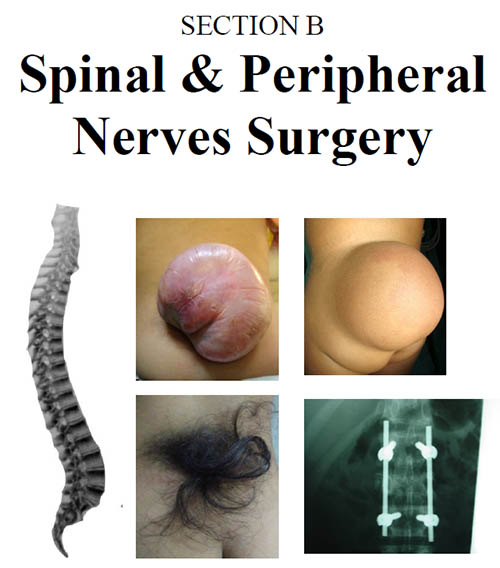Outcome of Surgical Treatment for Lumber Disc Herniation Causing Painful Incomplete Foot-Drop
DOI:
https://doi.org/10.36552/pjns.v24i3.398Abstract
Objective: To determine the outcome of surgical treatment for lumder disc herniation causing the painful incomplete foot drop.
Material and Methods: This retrospective observational study was conducted at the Department of Neurosurgery Lady Reading Hospital, Peshawar. Both Male and female patients with lumbar disc disease causing unilateral incomplete painful foot drop were included in our study. Patients with complete or painless foot drop, bilateral foot-drop, Multiple level disc prolapse, cauda equina syndrome or sciatic neuropathy due to injection injury were excluded. Patients were followed was post-operatively in terms of power in foot dorsiflexion, medical research council (MRC) grade and pain relief on a Visual Analogue Scale (VAS) after 1 month and then after 6 months.
Results: Total number of patients included were 43. Age was ranging from 18 years to 54 years and mean age was 33 years. Before surgery, power of MRC grade 3 or less, but greater than 1 in dorsiflexion was noted in all patients. The pain was scaled using VAS. Post peratively, at 1 month follow up, the foot-drop improved to MRC grade 4 or 5 along with pain relief of ? 2 points on VAS in 81. 4% (n = 35) patients and at 6 month follow-up, the figure rose to 93% (n = 40).
Conclusion: Lumbar disc disease can cause a debilitating foot-drop and pain. Improving or restoring a neurology early surgical intervention has proven benefits.
References
2. Khatak A, Rehman L, Haider A, Ali M, Mushtaq and Ilyas. Surgical outcome of lumber disc surgery in 250 patients. Pak J. of Neurol. Surg. 2008; 12 (2): 27-31.
3. Moore KL, Agur AMR. Essential clinical anatomy. 3rd ed. Philadelphia, PA: Lippincott Williams & Wilkins; 2007: p. 692.
4. Masakado Y, Kawakami M, Suzuki K, Abe L, Ota T et al. Clinical neurophysiology in the diagnosis of peroneal nervepalsy. Keio J Med. 2008; 57: 84-89.
Doi: 10. 2302/kjm. 57. 84. PubMed:18677088.
5. Stewart JD. Foot drop: where, why and what to do? Prac Neurol. 2008; 8: 158-169. Doi: 10. 1136/jnnp. 2008. 149393.
6. Voermans NC, Koetsveld AC, Zwarts MJ. Segmental overlap: foot drop in S1 radiculopathy. Acta Neurochir. 2006; 148: 809-813. Doi: 10. 1007/s00701-006-0754-0. PubMed:16523224.
7. Aono H, Iwasaki M, Ohwada T, Okuda S, Hosono N
et al. Surgical outcome of drop foot caused by degenerative lumbar diseases. Spine, 2007; 32: E262–E266. Doi: 10. 1097/01. brs. 0000251884. 94821. c0. PubMed:17426622.
8. McCulloch JA, Waddell G. Variation of the lumbosacral myotomes with bony segmental anomalies. J Bone Joint Surg Br. 1980; 62: 475–480. Pub Med: 7430228.
9. Hijikata SA. A method percutaneous nuclear extraction. Journal of Toden Hospital, 1975; 5: 39-42.
10. Postacchini F, Giannicola G, Cinotti G. Recovery of motor de?cits after microdiscectomy for lumbar disc herniation. J Bone Joint Surg Br. 2002; 84: 1040–1045.
11. Aono H, Iwasaki M, Ohwada T. et al. Surgical outcome of drop foot caused by degenerative lumbar diseases. Spine, 2007; 32: E262–E266.
12. Guigui P, Benoist M, Delecourt C, Delhoume J, Deburge A. Motor de?citin lumbar spinal stenosis: a retrospective study of a series of 50 patients. J Spinal Disord. 1998; 11: 283-288.
13. Alamgir, Ali M, Sharafat S, Khan Z, Khan KM, Usman M, et al. Analysis of patients operated for lumber disc herniation. Pak J. of Neurol. Surg. 2009; 13 (2): 103-07.
14. Michael A, Adams, Peter J and Roughly. What is intervertebral Disc Degeneration and what causes it? Spine, 2006; 14 (2): 101-08.
15. Tureyen K. One level one sided lumber disc surgery with and without microscopic assistance: 1 year outcome in 114 conservative patients. J Neurosurg. 2003; 99: 247-50.
16. Bhargava D, Sinha P, Odak S, Tyagi A, Towns G, Pal D. Surgical outcome for foot drop in lumbar degenerative disease. Global Spine J. 2012; 2: 125–128.
17. Iizuka Y, Iizuka H, Tsutsumi S, et al. Foot drop due to lumbar degenerative conditions: mechanism and prognostic factors in herniated nucleus pulposus and lumbar spinal stenosis. J Neurosurg Spine, 2009; 10: 260–264.
18. Liu K, Zhu W, Shi J, Jia L, Shi G, Wang Y, Liu N. Foot drop caused by lumbar degenerative disease: clinical features, prognostic factors of surgical outcome and clinical stage. PLoSOne, 2013; 8: e80375.
19. Takenaka, S. & Aono, H. Clin Orthop Relat Res. 2017; 475: 872. Doi: 10. 1007/s11999-016-5180-x.

Downloads
Published
Issue
Section
License
The work published by PJNS is licensed under a Creative Commons Attribution-NonCommercial 4.0 International (CC BY-NC 4.0). Copyrights on any open access article published by Pakistan Journal of Neurological Surgery are retained by the author(s).












